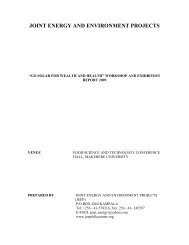Create successful ePaper yourself
Turn your PDF publications into a flip-book with our unique Google optimized e-Paper software.
Effluent discharge pump<br />
A pump moves the digested biomass to a<br />
storage tank. In simple plants, and with a<br />
suitable arrangement of pipes and valves, one<br />
pump can take care of both the feeding and<br />
discharge.<br />
Digestate storage tank<br />
The purpose of the storage tank (or secondary<br />
digester) is to act as a buffer tank before the<br />
digested biomass can be transported away to be<br />
finally stored in the farmer’s own storage tank<br />
or applied as fertiliser directly on farmland.<br />
The tank is usually covered, partly to prevent<br />
the entry of rainwater and partly to<br />
prevent the loss of ammonia. If there is a long<br />
retention time, there will additionally be a certain<br />
amount of gas produced from the storage<br />
tank as the biomass in a fully stirred reactor<br />
will never be completely digested. This gas can<br />
also be extracted and used.<br />
1<br />
tHe gas system<br />
Gas condensation<br />
The biogas produced in the reactor and secondary<br />
digester (if used) is extracted. The gas is<br />
warm and therefore contains a large amount of<br />
water vapour. When cooled, most of this water<br />
will condense out and can then be pumped<br />
back to the secondary digester.<br />
Gas purification<br />
Besides methane and carbon dioxide, the gas also contains<br />
a smaller amount of hydrogen sulphide (H 2 S).<br />
The amount is proportional to the protein content of<br />
the biomass. The higher the protein level, the higher<br />
the H 2 S production. If the biogas is intended to be<br />
used in a combustion engine, the H 2 S-content has to<br />
be removed from the gas, as it is corrosive in combination<br />
with CO 2 and water vapour. This can be done<br />
in a biological process, where the ability of sulphur<br />
bacteria to degrade hydrogen sulphide to pure sulphur<br />
or sulphuric acid is utilised. This sulphur in an aqueous<br />
solution is pumped to the secondary storage tank<br />
and therefore recycled to the field and crops.<br />
Gas storage<br />
In order to even out the gas production, most<br />
plants also have a gas store with capacities<br />
ranging from two to 24 hours of production. <strong>Biogas</strong><br />
takes up a lot of space and it is rarely worth<br />
having a large storage capacity.<br />
Gas transmission<br />
At several plants the purified gas is subsequently<br />
pumped from 5-10 km in a gas transmission pipe<br />
to a local combined heat and power plant, where<br />
the biogas may replace natural gas.

















